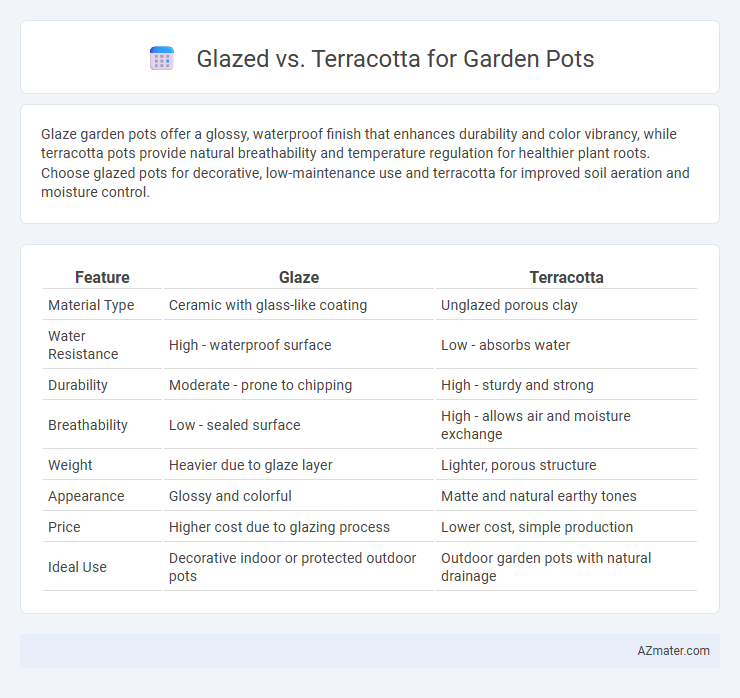Glaze garden pots offer a glossy, waterproof finish that enhances durability and color vibrancy, while terracotta pots provide natural breathability and temperature regulation for healthier plant roots. Choose glazed pots for decorative, low-maintenance use and terracotta for improved soil aeration and moisture control.
Table of Comparison
| Feature | Glaze | Terracotta |
|---|---|---|
| Material Type | Ceramic with glass-like coating | Unglazed porous clay |
| Water Resistance | High - waterproof surface | Low - absorbs water |
| Durability | Moderate - prone to chipping | High - sturdy and strong |
| Breathability | Low - sealed surface | High - allows air and moisture exchange |
| Weight | Heavier due to glaze layer | Lighter, porous structure |
| Appearance | Glossy and colorful | Matte and natural earthy tones |
| Price | Higher cost due to glazing process | Lower cost, simple production |
| Ideal Use | Decorative indoor or protected outdoor pots | Outdoor garden pots with natural drainage |
Introduction to Garden Pots
Garden pots play a crucial role in enhancing plant growth and aesthetic appeal while providing necessary drainage and soil containment. Glazed pots feature a smooth, waterproof coating that prevents moisture loss and adds vibrant color, making them ideal for decorative use. Terracotta pots are made from porous clay, allowing air and water to pass through, benefiting plant roots by preventing overwatering and promoting healthy growth.
What is Glazed Pottery?
Glazed pottery features a vitreous coating applied to ceramics, creating a smooth, glossy surface that enhances water resistance and durability for garden pots. This glaze can vary in color, texture, and finish, providing both aesthetic appeal and functional benefits such as preventing moisture absorption and reducing the risk of cracking in outdoor environments. Unlike unglazed terracotta, glazed pots offer increased protection against weather elements, making them a popular choice for long-lasting garden containers.
What is Terracotta Pottery?
Terracotta pottery, made from natural clay fired at low temperatures, is celebrated for its porous texture and warm, earthy tones ideal for garden pots. These pots provide excellent breathability, promoting healthy root growth by allowing air and moisture exchange. Unlike glaze-coated pots that offer a glossy finish and water resistance, terracotta pots naturally regulate soil moisture, making them a preferred choice for plants requiring well-drained environments.
Aesthetic Differences: Glazed vs Terracotta
Glazed garden pots offer a shiny, vibrant surface with a wide range of colors and patterns, enhancing the visual appeal of outdoor spaces with their smooth and reflective finish. Terracotta pots provide a natural, earthy aesthetic due to their porous, matte texture and warm, reddish-brown tones that complement rustic and traditional garden styles. The choice between glazed and terracotta pots depends on whether a bold, decorative statement or a classic, organic look is desired for garden design.
Durability and Weather Resistance
Glazed garden pots offer enhanced durability due to their protective coating, which makes them resistant to moisture, stains, and temperature fluctuations. Terracotta pots, while porous and breathable, are more prone to cracking and weather damage, especially in freezing conditions. Choosing glazed pots ensures longer-lasting garden containers that withstand harsh weather better than traditional terracotta options.
Porosity and Plant Health
Glaze on garden pots creates a non-porous surface that helps retain moisture, reducing the frequency of watering and protecting plants from root rot caused by overwatering. Terracotta, being porous, allows air and water to pass through its walls, promoting better aeration and preventing soil from becoming waterlogged, which supports healthy root development. Choosing between glazed and terracotta pots depends on the plant's water needs and the growing environment, with terracotta preferred for plants requiring excellent drainage and glazed pots ideal for moisture-loving plants.
Maintenance and Cleaning
Glazed garden pots offer a smooth, non-porous surface that resists dirt and retains moisture, making maintenance straightforward with simple wiping or rinsing. Terracotta pots, being porous, absorb water and soil residues, requiring more frequent cleaning to prevent mold and mineral buildup, often involving scrubbing and soaking. Regular care of terracotta ensures durability, while glazed pots provide a low-maintenance option ideal for preserving plant health and pot appearance.
Cost Comparison
Glazed garden pots generally cost more than terracotta due to the additional manufacturing steps involving glassy coating, which enhances durability and color variety. Terracotta pots are typically more affordable, made from natural clay that is molded and fired with minimal processing, making them a budget-friendly option for gardeners. Cost differences can vary depending on brand, size, and design, but terracotta remains the economical choice for cost-conscious buyers.
Best Uses for Glazed Pots
Glazed pots offer superior resistance to moisture and stains, making them ideal for outdoor garden settings where frequent watering occurs. Their non-porous surface prevents soil from drying out too quickly, which benefits moisture-loving plants like ferns and tropical species. These pots also maintain vibrant color and texture, enhancing aesthetic appeal while providing durable protection against weather elements.
Best Plants for Terracotta Pots
Terracotta pots are ideal for Mediterranean herbs like rosemary, thyme, and oregano, as their porous material allows for excellent air and moisture circulation, preventing root rot. Succulents and cacti also thrive in terracotta due to its quick drying properties, which reduce the risk of overwatering. In contrast, glazed pots retain moisture longer, making them better suited for moisture-loving plants like ferns and begonias.

Infographic: Glaze vs Terracotta for Garden Pot
 azmater.com
azmater.com